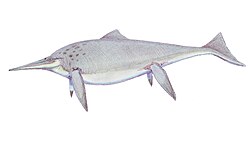Shonisaurus

Shonisaurus is the largest ichthyosaur, and the largest extinct marine animal that has yet been found.[1] It was found first in rocks of the Upper Triassic in Nevada, and later in British Columbia.[2]
Discovery and description
Fossils of Shonisaurus were first found in a large deposit in Nevada in 1920. Thirty years later, they were excavated, uncovering the remains of 37 very large ichthyosaurs. These were named Shonisaurus, ("Lizard from the Shoshone Mountains"). Shonisaurus lived 216–203 million years ago.
S. popularis was about 15 metres (50 ft) long. A longer specimen is now placed in Shastasaurus rather than Shonisaurus. Shonisaurus had a long pointed mouth that contained teeth only at the front end.[1] It had a large whale-like body, a long dolphin-like snout, and its flippers were much longer, and narrower than in other ichthyosaurs. All of these features suggest that Shonisaurus may be a relatively specialised offshoot of the main ichthyosaur evolutionary line.[3]
Thus, due to being, perhaps, a slow-moving animal, it may have fed like a modern-day whale shark, taking large amounts of small prey. Whale sharks sometimes feed on schooling fish, and small sharks and the extinct Saurichthys, along with ammonites, belemnites and squid, would've supplemented Shonisaurus.
Fossils
The first species discovered, S. popularis, was adopted as the state fossil of Nevada in 1984. Excavations, begun in 1954 under the direction of Charles Camp and Samuel Welles of the University of California, Berkeley, were continued by Camp throughout the 60s.[1]
The Nevada fossil is at the Berlin–Ichthyosaur State Park, Nevada, USA. The park has several undisturbed ichthyosaur fossils of the species Shonisaurus popularis as well as the early-20th Century ghost town of Berlin. The park is about 150 miles (240 km) east of Reno.
The discovery of S. sikkanniensis in British Columbia in the 1990s made S. popularis the smaller of the Shonisaurus species. An ichthyosaur found in the Himalayan mountains called Himalayasaurus, may be the same animal as Shonisaurus.
British Columbia specimen
The British Columbia specimen was described as follows:
- "The ichthyosaur Shonisaurus sikanniensis... type specimen is considerably larger than Shonisaurus popularis, with an estimated length of 21 m. It also differs from S. popularis in having a fan-shaped scapula, and relatively longer vertebral centra... Teeth are set in sockets, but are known only in a few, small individuals. This implies that teeth were present only in juveniles, and that adults were edentulous (without teeth).[2]
- "Isolated elements from other localities suggest that larger individuals existed... The [site] ... is from the final stage of a late Triassic marine transgression (deepening) along the north-west coast of Pangea. It was deposited in a deep-water, distant shelf setting, well below wave base".[2]
Life-style
Its slender skull and lack of teeth except at the front are obvious adaptations to its method of feeding. They are like those of modern whales which feed on squid, such as the pilot whale and sperm whale.[4]
Shonisaurus Media
Size of S. popularis (green) and Shastasaurus sikanniensis (red) compared with a human (blue)
References
- ↑ 1.0 1.1 1.2 Hilton, Richard P. 2003. Dinosaurs and other Mesozoic animals of California, University of California Press, Berkeley. ISBN 0-520-23315-8, pages 90-91.
- ↑ 2.0 2.1 2.2 Nicholls, Elizabeth L.; Manabe, Makoto (2004). "Giant ichthyosaurs of the Triassic—a new species of Shonisaurus from the Pardonet Formation (Norian: Late Triassic) of British Columbia". Journal of Vertebrate Paleontology. 24 (4): 838. doi:10.1671/0272-4634(2004)024[0838:GIOTTN]2.0.CO;2. ISSN 0272-4634. S2CID 130274656.
- ↑ Palmer, D., ed. (1999). The Marshall illustrated encyclopedia of dinosaurs and prehistoric animals. London: Marshall Editions. pp. 78–79. ISBN 1-84028-152-9.
- ↑ McGowan, Christopher 1997. The raptor and the lamb: predators and prey in the living world. Henry Holt and Penguin, p192. ISBN 0-14-027264-X
- Camp C.L. 1980. Large ichthyosaurs from the Upper Triassic of Nevada. Palaeontographica, Abteilung A, 170:139-200.
- Camp C.L. 1981. Child of the rocks, the story of Berlin-Ichthyosaur State Park. Nevada Bureau of Mines and Geology special publication 5.
Other websites
- Nevada Division of State Parks Archived 2009-05-21 at the Wayback Machine




